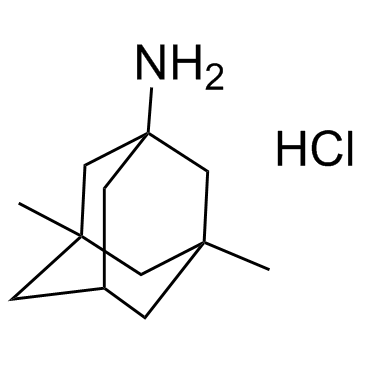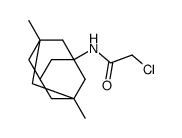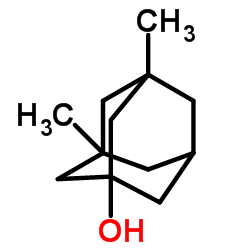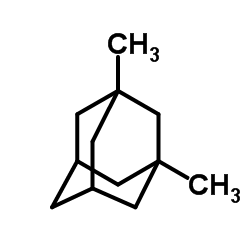memantine
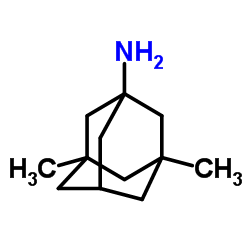
memantine structure
|
Common Name | memantine | ||
|---|---|---|---|---|
| CAS Number | 19982-08-2 | Molecular Weight | 179.302 | |
| Density | 1.0±0.1 g/cm3 | Boiling Point | 239.8±8.0 °C at 760 mmHg | |
| Molecular Formula | C12H22ClN | Melting Point | 153ºC | |
| MSDS | N/A | Flash Point | 92.3±9.7 °C | |
| Name | memantine |
|---|---|
| Synonym | More Synonyms |
| Density | 1.0±0.1 g/cm3 |
|---|---|
| Boiling Point | 239.8±8.0 °C at 760 mmHg |
| Melting Point | 153ºC |
| Molecular Formula | C12H22ClN |
| Molecular Weight | 179.302 |
| Flash Point | 92.3±9.7 °C |
| Exact Mass | 179.167404 |
| PSA | 26.02000 |
| LogP | 3.18 |
| Vapour Pressure | 0.0±0.5 mmHg at 25°C |
| Index of Refraction | 1.554 |
| Storage condition | Store at RT |
Synonym:1-Amino-3,5-dimethyladamantane hydrochloride; Memantine hydrochloride; 3,5-Dimethyl-1-adamantanamine hydrochloride; DMAA hydrochloride; Tricyclo(3.3.1.1(sup 3,7))decan-1-amine hydrochloride Section 2 - COMPOSITION, INFORMATION ON INGREDIENTS
Risk Phrases: None Listed. Section 3 - HAZARDS IDENTIFICATION EMERGENCY OVERVIEW
Not available. Potential Health Effects Eye: Dust may cause mechanical irritation. Skin: May cause skin irritation. Ingestion: May cause irritation of the digestive tract. May cause central nervous system effects and/or neurological effects. Inhalation: May cause respiratory tract irritation. Chronic: No information found. Section 4 - FIRST AID MEASURES Eyes: Flush eyes with plenty of water for at least 15 minutes, occasionally lifting the upper and lower eyelids. Get medical aid immediately. Skin: Get medical aid. Flush skin with plenty of water for at least 15 minutes while removing contaminated clothing and shoes. Wash clothing before reuse. Ingestion: If victim is conscious and alert, give 2-4 cupfuls of milk or water. Never give anything by mouth to an unconscious person. Get medical aid. Inhalation: Remove from exposure and move to fresh air immediately. If not breathing, give artificial respiration. If breathing is difficult, give oxygen. Get medical aid. Notes to Physician: Section 5 - FIRE FIGHTING MEASURES General Information: As in any fire, wear a self-contained breathing apparatus in pressure-demand, MSHA/NIOSH (approved or equivalent), and full protective gear. During a fire, irritating and highly toxic gases may be generated by thermal decomposition or combustion. This material in sufficient quantity and reduced particle size is capable of creating a dust explosion. Extinguishing Media: Use water spray, dry chemical, carbon dioxide, or appropriate foam. Section 6 - ACCIDENTAL RELEASE MEASURES General Information: Use proper personal protective equipment as indicated in Section 8. Spills/Leaks: Vacuum or sweep up material and place into a suitable disposal container. Avoid generating dusty conditions. Provide ventilation. Section 7 - HANDLING and STORAGE Handling: Wash thoroughly after handling. Remove contaminated clothing and wash before reuse. Use with adequate ventilation. Minimize dust generation and accumulation. Avoid contact with eyes, skin, and clothing. Avoid breathing dust. Storage: Keep container closed when not in use. Store in a cool, dry, well-ventilated area away from incompatible substances. Section 8 - EXPOSURE CONTROLS, PERSONAL PROTECTION Engineering Controls: Use adequate ventilation to keep airborne concentrations low. Exposure Limits CAS# 19982-08-2: CAS# 41100-52-1: Personal Protective Equipment Eyes: Wear appropriate protective eyeglasses or chemical safety goggles as described by OSHA's eye and face protection regulations in 29 CFR 1910.133 or European Standard EN166. Skin: Wear appropriate protective gloves to prevent skin exposure. Clothing: Wear appropriate protective clothing to minimize contact with skin. Respirators: Follow the OSHA respirator regulations found in 29 CFR 1910.134 or European Standard EN 149. Use a NIOSH/MSHA or European Standard EN 149 approved respirator if exposure limits are exceeded or if irritation or other symptoms are experienced. Section 9 - PHYSICAL AND CHEMICAL PROPERTIES Physical State: Powder Color: white Odor: None reported. pH: Not available. Vapor Pressure: Not available. Viscosity: Not available. Boiling Point: Not available. Freezing/Melting Point: 258 deg C Autoignition Temperature: Not applicable. Flash Point: Not applicable. Explosion Limits, lower: N/A Explosion Limits, upper: N/A Decomposition Temperature: Solubility in water: Specific Gravity/Density: Molecular Formula: C12H21NHCl Molecular Weight: 215.77 Section 10 - STABILITY AND REACTIVITY Chemical Stability: Stable under normal temperatures and pressures. Conditions to Avoid: Dust generation. Incompatibilities with Other Materials: Strong oxidizing agents. Hazardous Decomposition Products: Hydrogen chloride, nitrogen oxides, carbon monoxide, carbon dioxide. Hazardous Polymerization: Has not been reported. Section 11 - TOXICOLOGICAL INFORMATION RTECS#: CAS# 19982-08-2: YD1958750 CAS# 41100-52-1 unlisted. LD50/LC50: Not available. Not available. For CAS 19982-08-2, the free base: TDLo Intramuscular (rat): 14.2 mg/kg anticonvulsant. (RTECS) Carcinogenicity: 1,3-Dimethyl-5-aminoadamantane (the free base) - Not listed by ACGIH, IARC, or NTP. 1,3-Dimethyl-5-aminoadamantane hydrochloride - Not listed by ACGIH, IARC, or NTP. Other: See actual entry in RTECS for complete information. Section 12 - ECOLOGICAL INFORMATION Section 13 - DISPOSAL CONSIDERATIONS Dispose of in a manner consistent with federal, state, and local regulations. Section 14 - TRANSPORT INFORMATION IATA Not regulated as a hazardous material. IMO Not regulated as a hazardous material. RID/ADR Not regulated as a hazardous material. Section 15 - REGULATORY INFORMATION European/International Regulations European Labeling in Accordance with EC Directives Hazard Symbols: Not available. Risk Phrases: Safety Phrases: S 24/25 Avoid contact with skin and eyes. WGK (Water Danger/Protection) CAS# 19982-08-2: No information available. CAS# 41100-52-1: No information available. Canada None of the chemicals in this product are listed on the DSL/NDSL list. CAS# 19982-08-2 is not listed on Canada's Ingredient Disclosure List. CAS# 41100-52-1 is not listed on Canada's Ingredient Disclosure List. US FEDERAL TSCA CAS# 19982-08-2 is not listed on the TSCA inventory. It is for research and development use only. CAS# 41100-52-1 is not listed on the TSCA inventory. It is for research and development use only. SECTION 16 - ADDITIONAL INFORMATION N/A |
|
~90% 
memantine CAS#:19982-08-2 |
| Literature: SAIRAM ORGANICS PVT. LTD.; PHARMACEUTICAL SOLUTIONS FZCO Patent: WO2009/153806 A2, 2009 ; Location in patent: Page/Page column 7 ; |
|
~42% 
memantine CAS#:19982-08-2 |
| Literature: CIPLA LIMITED; PATHI, Srinivas, Laxminarayan; KANKAN, Rajendra, Narayanrao; CURTIS, Philip, Anthony Patent: WO2010/7351 A1, 2010 ; Location in patent: Page/Page column 13 ; |
|
~% 
memantine CAS#:19982-08-2 |
| Literature: WO2007/117544 A2, ; Page/Page column 38-39 ; |
|
~73% 
memantine CAS#:19982-08-2 |
| Literature: HEXAL AG Patent: WO2007/96124 A1, 2007 ; Location in patent: Page/Page column 12; 13-14 ; |
|
~% 
memantine CAS#:19982-08-2 |
| Literature: Journal of Medicinal Chemistry, , vol. 6, p. 760 - 763 |
|
~% 
memantine CAS#:19982-08-2 |
| Literature: EP1908748 A1, ; Page/Page column 8 ; |
|
~% 
memantine CAS#:19982-08-2
Detail
|
| Literature: WO2008/62472 A2, ; Page/Page column 16-17 ; |
|
~% 
memantine CAS#:19982-08-2 |
| Literature: Asian Journal of Chemistry, , vol. 24, # 11 p. 5107 - 5110 |
|
~% 
memantine CAS#:19982-08-2 |
| Literature: WO2010/69555 A1, ; Page/Page column 19-21 ; |
| HS Code | 2921300090 |
|---|---|
| Summary | 2921300090 other cyclanic, cyclenic or cyclotherpenic mono- or polyamines, and their derivatives; salts thereof。Supervision conditions:None。VAT:17.0%。Tax rebate rate:9.0%。MFN tariff:6.5%。General tariff:30.0% |
| Acid salts MeMantine |
| memantine |
| 3,5-Dimethyl-1-adamantylamine |
| MFCD02114015 |
| 3,5-dimethyltricyclo[3.3.1.1]decan-1-amine |
| Memantina [INN-Spanish] |
| 3,5-Dimethyl-1-adamantanamine |
| 3,5-Dimethyladamantan-1-amine |
| 1,3-Dimethylaminoadamantane |
| MEMENTINE HYDROCHHLORIDE |
| Tricyclo[3.3.1.1]decan-1-amine, 3,5-dimethyl- |
| tricyclo[3.3.1.13,7]decan-1-amine, 3,5-dimethyl- |
| 3,5-dimethyltricyclo[3.3.1.13,7]decan-1-amine |
| 3,5-Dimethyl-1-aminoadamantane |
| AURORA KA-7643 |
| 3,5-Dimethyladamantan-1-ylamine |
| 1,3-dimethyl-5-aminoadamantane |
| 1-amino-3,5-dimethyl-adamantane |


